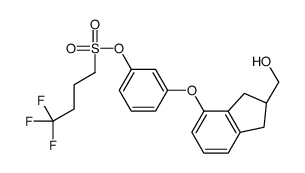212188-60-8
| Name | [3-[[(2R)-2-(hydroxymethyl)-2,3-dihydro-1H-inden-4-yl]oxy]phenyl] 4,4,4-trifluorobutane-1-sulfonate |
|---|---|
| Synonyms |
UNII-SRX4T6TMUS
(-)-Bay-38-7271 1-Butanesulfonic acid,4,4,4-trifluoro-,3-(((2R)-2,3-dihydro-2-(hydroxymethyl)-1H-inden-4-yl)oxy)phenyl ester |
| Description | BAY 38-7271 is selective and highly potent and cannabinoid CB1/CB2 receptor agonist, with Kis of 1.85 nM and 5.96 nM for recombinant human CB1 receptor and CB2 receptor, respectively. BAY 38-7271 has strong neuroprotective properties[1]. |
|---|---|
| Related Catalog | |
| Target |
CB1:1.85 nM (Ki) CB2:5.96 nM (Ki) |
| In Vitro | BAY 38-7271 shows only minor interactions at the micromolar range with other binding sites such as adenosine A3 receptor (IC50 = 7.5 μM), peripheral GABAA benzodiazepine receptor (IC50 = 971 nM), melatonin ML1 receptor (IC50 = 3.3 μM), and at the monoamine transporter (IC50 = 1.7 μM)[1]. |
| In Vivo | BAY 38-7271 (Ed50 = 0.02 mg/kg; i.v. and 0.5 mg/kg; i.p.) induces a potent and dose-de-pendent reduction in core body temperature[1]. BAY 38-7271 has low physical dependence liability and is not essentially different from that of other cannabinoid CB1 receptor agonists[1]. BAY 38-7271 (1-1000 ng/kg/h; i.v. infusion; for 4 hours) shows neuroprotective efficacy in the rat SDH model[1]. BAY 38-7271 also has neuroprotective efficacy in models of transient and permanent occlusion of the middle cerebral artery and brain edema models[1]. Animal Model: Wistar rat ,TBI rat models (acute subdural hematoma, SDH)[1] Dosage: 1 ng/kg/h, 10 ng/kg/h, 100 ng/kg/h, 1000 ng/kg/h Administration: Intravenous infusion, for 4 hours Result: Reduced the mean infarct volume. |
| References |
| Density | 1.351 g/cm3 |
|---|---|
| Boiling Point | 527.206ºC at 760 mmHg |
| Molecular Formula | C20H21F3O5S |
| Molecular Weight | 430.43800 |
| Flash Point | 272.645ºC |
| Exact Mass | 430.10600 |
| PSA | 81.21000 |
| LogP | 5.31790 |
